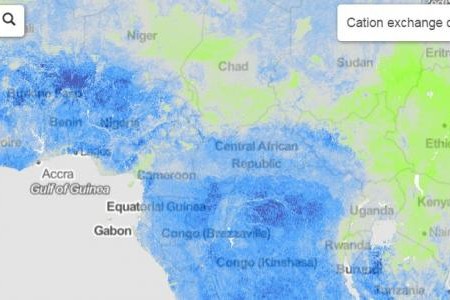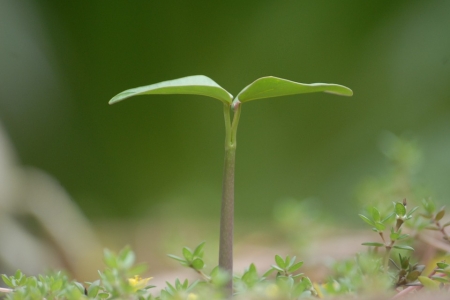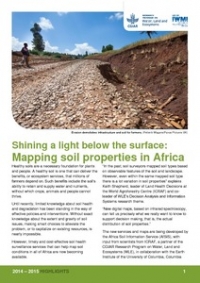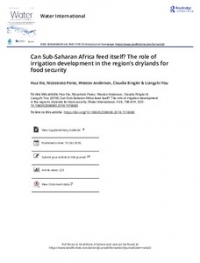Originally published on Spore Magazine.
Even without climate change, there is an enormous challenge to meet the growing demand for food with the current status of soil health in sub-Saharan Africa (SSA). By 2050, SSA’s population will increase 2.5-fold and demand for cereals will approximately triple. Current cereal consumption already depends on substantial imports. To maintain the current level of about 80% cereal self-sufficiency, by 2050, nearly complete closure of the gap between current farm yields and water-limited yield potential is needed, which is in the range of 20 to 50%. Failure to close the yield gap on existing cropland will result in expansion of cultivation to less favourable land, resulting in biodiversity loss and increased greenhouse gas emissions and dependency on imported food.
Closing the yield gaps is possible but represents a herculean task given historical trends in yield improvements. Lack of investment in lime, fertilisers and organic inputs in SSA has generally stifled the build-up of fertility in soils. And, while there has been vast investment in nutrient inputs on other continents over recent decades, often heavily subsidised, in SSA the reverse is true. Soils have been increasingly intensively cultivated over several decades with few inputs after clearing the land from natural vegetation. This has led to decreases in soil organic matter and, with it, decreases in key soil functions: soils’ ability to retain and supply nutrients, infiltrate and store water, and resist erosion. Soil nutrient stocks, especially of phosphorus, are inherently low in many regions of SSA, and require investment in mineral phosphate fertilisers to overcome crop deficiencies. Chronically low crop yields further decrease the amount of organic matter being returned to soils through roots and other organic residues, and expose the soil to erosion. The general lack of investment in inputs has put SSA soils on a downward re-enforcing trend of degradation in soil health.
Cultivating cereals in the face of climate change
Even without considering soil health, climate change is likely to reduce yields of major cereal crops across SSA, affecting both food availability and access. Reduced precipitation, higher temperatures and extreme events, such as floods and drought, are already reducing the yields of staple food crops in some areas. By 2050, climate change in SSA may cause another 35 million people to be food insecure. Maize yields may be reduced by as much as 20% across SSA, and regions where growing conditions may improve due to global warming, such as higher altitude areas in Eastern Africa, would require relocating the main maize growing areas from lower altitudes.
Soil degradation increases the risks of climate change impacts on agriculture by impairing key soil functions. Conversely, greater investment in building soil health would improve resilience. Healthy soils are better able to buffer crops during drought periods by infiltrating and storing more water, by better resisting heavier rain storms, and through improved soil fertility allow crops to better resist pests and diseases. Increasing resistance to soil erosion not only reduces on-site degradation but also reduces negative off-site impacts of soil erosion on water quality and silting of dams.
Improving soil health will require a suite of actions targeted to farmer needs and abilities. Judicious use of fertilisers and organic resources, and increased biological nitrogen fixation, are important steps. These must be combined with practices that increase the efficiency of those inputs through greater nutrient cycling, crop diversification, and return of organic residue to soils; such as agroforestry, agroecology, intercropping, crop rotation, cover cropping, conservation tillage, integrated pest management, and integrated crop-animal farming.
The Africa Soil Information Service (AfSIS) has been working over the past decade to introduce new approaches to digital mapping of soil properties, which are helping better target interventions to soil constraints with a particular focus on Ethiopia, Ghana, Nigeria and Tanzania. AfSIS has deployed statistically rigorous soil sampling designs in the field, new rapid soil measurement methods in the laboratory that use only light instead of chemical extractions, and artificial intelligence methods that calibrate the measured soil properties to satellite imagery so they can be mapped.
Now the challenge is to get these technologies and best practices working directly for farmers to help them adapt to climate change by improving resilience, contribute to climate change mitigation by sequestering more carbon in soils, and in some cases, reduce greenhouse gas emissions. A key need to accelerate adoption of good practice is to reduce farmers’ decision risk associated with input use through better agronomic advisory services; better access to appropriate and high-quality inputs, credit and insurance; and more secure markets. iSDA (Innovative Solutions for Decision Agriculture) is a social enterprise spun out by the World Agroforestry Centre in Nairobi, the International Institute of Tropical Agriculture in Nigeria and Rothamsted Research to help translate the outputs of AfSIS to help millions of smallholders across Africa.









Comments
We are interested in soil health for increased production and plant protection by using microorganisms and making them available to plant root hairs at propagation and in so doing reduce the amount of applied fertiliser and eliminating biocides.